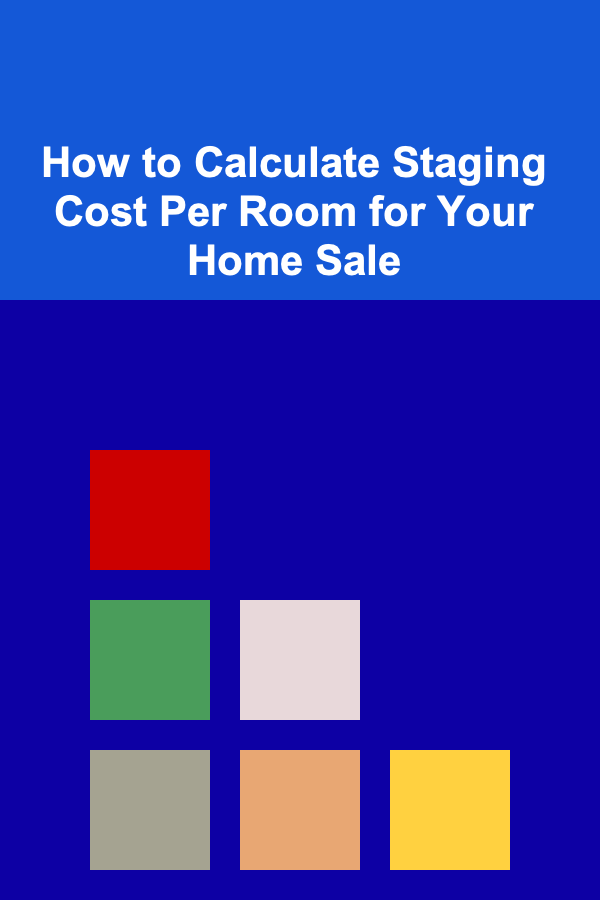
How to Calculate Staging Cost Per Room for Your Home Sale
ebook include PDF & Audio bundle (Micro Guide)
$12.99$11.99
Limited Time Offer! Order within the next:

Staging a home effectively can significantly influence its sale price and how quickly it sells. However, many homeowners are often concerned about the costs associated with staging. Understanding how to calculate staging costs per room can help you manage your budget effectively while maximizing the return on your investment. This article will provide a comprehensive overview of how to approach staging, the factors that influence costs, and a detailed breakdown of how to calculate and manage these expenses for each room in your home.
The Importance of Home Staging
1. Creating a Compelling First Impression
First impressions play a crucial role in real estate sales. Buyers often make decisions within minutes of entering a property. Proper staging can ensure that your home stands out in the eyes of potential buyers, helping them envision themselves living there.
2. Highlighting Key Features
A well-staged home accentuates its best features, whether they be architectural details, spaciousness, or outdoor areas. This not only creates an inviting atmosphere but also showcases the home's potential, leading to better offers.
3. Reducing Time on Market
Research indicates that staged homes sell faster than their non-staged counterparts. By presenting a move-in-ready appearance, sellers can attract more interest and potentially generate multiple offers.
4. Maximizing Sale Price
Investing in staging can yield substantial returns. According to industry experts, staged homes can sell for up to 20% more than similar unstaged properties. Thus, understanding how to budget for staging can directly impact your profit margins.
Factors Influencing Staging Costs
Before diving into calculations, it's essential to understand the various factors that influence staging costs.
1. Size of the Home
Larger homes typically require more time, effort, and resources to stage. A two-bedroom apartment will generally cost less to stage than a five-bedroom house.
2. Number of Rooms
The number of rooms being staged has a direct impact on costs. Each room requires individual attention in terms of decorating, furniture arrangement, and sometimes even repairs.
3. Level of Professional Help
Deciding whether to hire a professional stager, use a DIY approach, or a mix of both will greatly influence your overall costs. Professional stagers bring expertise but come at a premium.
4. Location
Market conditions and local real estate trends can influence staging costs. For instance, urban areas may have higher rates due to demand for stagers, while rural areas might offer more affordable options.
5. Quality of Furnishings and Decor
The quality and style of furnishings used for staging can vary widely. High-end pieces will obviously elevate costs compared to using basic items or existing furniture from the homeowner.
6. Duration of Staging
How long you plan to stage the home also plays a crucial role. Some stagers charge by the month, meaning longer staging periods can lead to increased costs.
Calculating Staging Costs
Now that we've identified the various factors influencing staging costs, let's delve into how to calculate these expenses effectively.
Step 1: Assess Each Room
Begin by assessing each room individually. Make a list of all rooms you plan to stage, including:
- Living Room
- Kitchen
- Dining Room
- Bedrooms
- Bathrooms
- Hallways
- Outdoor Areas
Step 2: Determine Staging Options
For each room, decide whether you will use professional staging services or opt for a DIY approach. Consider the following:
- Professional Staging: Typically includes consultation, furniture rental, décor items, and installation.
- DIY Staging: Involves using your existing furniture, renting additional items, or purchasing décor.
Step 3: Estimate Costs
Professional Staging Costs
If you choose to hire professional help, here are some common cost structures:
- Consultation Fee: Many stagers charge an initial consultation fee ranging from $150 to $300.
- Room Staging Fees: Expect to pay between $500 and $1,500 per room for full staging, depending on size and location.
- Rental Fees: Furniture rentals may range from $100 to $800 per piece, depending on quality and type.
Example Calculation:
- Living Room: $1,000 (staging) + $200 (rental) = $1,200
- Bedroom: $700 (staging) + $150 (rental) = $850
- Kitchen: $500 (staging) + $100 (rental) = $600
DIY Approach Costs
If opting for DIY staging, consider the following expenses:
- Furniture Rentals: Renting furniture or decorations can range from $50 to $300 per item.
- Decor Purchases: Buying new decor items like pillows, artwork, and plants might cost anywhere from $100 to $500 total, depending on taste.
- Repairs and Cleaning: Allocate funds for any necessary repairs or deep cleaning, which could range from $200 to $1,000 based on the condition of the home.
Example Calculation:
- Living Room: $0 (using existing furniture) + $250 (decor purchases) = $250
- Bedroom: $100 (new bedding) + $50 (decor) = $150
- Bathroom: $75 (cleaning supplies) + $125 (new towels and decor) = $200
Step 4: Create a Detailed Breakdown
After estimating costs for each room, compile a detailed breakdown.
Sample Cost Breakdown Table
| Room | Professional Cost | DIY Cost | |-------------|-------------------|----------| | Living Room | $1200 | $250 | | Bedroom | $850 | $150 | | Kitchen | $600 | $200 | | Dining Room | $800 | $100 | | Bathroom | $500 | $200 | | Total | $3950 | $900 |
Step 5: Factor in Additional Costs
In addition to the above, remember to account for other potential expenses:
- Storage Costs: If you need to store excess furniture or belongings during the staging process, this could add extra costs.
- Utility Costs: Ensure utilities remain on during showings and open houses for comfort; factor in these costs as necessary.
- Marketing Costs: If staging is part of a larger marketing effort, include photography fees or advertising costs for showcasing your property.
Budgeting for Staging
Once you have a clear idea of your staging costs, the next step is budgeting effectively.
1. Set a Staging Budget
Determine how much you are willing to invest in staging. This budget should align with your overall selling strategy and financial goals.
2. Prioritize Key Areas
Focus your budget on the rooms that matter most. For example, prioritize staging the living room, kitchen, and master bedroom, as these areas tend to leave lasting impressions.
3. Adjust Based on Market Conditions
Consider current real estate market trends in your area. If homes are selling quickly without extensive staging, you may adjust your budget accordingly. Conversely, in a competitive market, investing more in staging may help differentiate your home.
4. Track Spending
Keep meticulous records of all expenses related to staging. Use spreadsheets or budgeting apps to monitor spending against your set budget.
Reaping the Benefits of Staging
The ultimate goal of calculating staging costs is to improve your home's marketability. Here's how effective staging can benefit you:
1. Increased Buyer Interest
Well-staged homes tend to receive more inquiries. An appealing presentation entices potential buyers to schedule viewings.
2. Shortened Selling Timeline
Staged homes often experience faster sales, reducing the time spent on the market. A quicker sale means less stress and lower holding costs.
3. Higher Offers
Buyers are often willing to pay more for a move-in-ready home that appeals to their emotions. Staging creates an inviting atmosphere that can command higher offers.
4. Competitive Edge
In markets with multiple listings, a well-staged home stands out. It distinguishes your property from others, making it more attractive to buyers.
Common Mistakes to Avoid When Staging
While staging can be incredibly beneficial, there are certain pitfalls to avoid.
1. Over-Personalization
Using too many personal items or family photos can prevent buyers from envisioning themselves in the space. Aim for a neutral, welcoming aesthetic.
2. Neglecting Repairs
Ignoring necessary repairs can deter buyers. Always take care of visible issues that could raise concerns or questions.
3. Poor Lighting Choices
Bad lighting choices can diminish appeal. Ensure light fixtures are clean and functional, and consider adding layers of lighting to create a warm atmosphere.
4. Cluttered Spaces
Even while staging, keep spaces organized. Clutter distracts from key features and can make rooms feel smaller.
5. Ignoring Outdoor Spaces
Don't underestimate the power of curb appeal. Ensure outdoor areas are tidy and inviting, as they contribute to first impressions.
Conclusion
Calculating staging costs per room is a vital aspect of preparing your home for sale. By understanding the various factors that influence these costs and implementing effective staging strategies, you can maximize the appeal of your home while managing your budget effectively.
Remember to assess each room carefully, estimate costs accurately, and prioritize investments based on potential returns. With thoughtful planning and execution, staging your home can lead to increased buyer interest, faster sales, and ultimately, a successful transaction that meets your financial goals.
By approaching the staging process with clarity and purpose, you'll enhance your home's marketability and create an inviting environment that resonates with potential buyers, ensuring that your efforts translate into tangible results.

How to Consider Pet Policies When Apartment Hunting: An Actionable Guide
Read More
How To Debunk the "Crisis Actor" Conspiracy Theory
Read More
How to Set Up a Check-in System for Volunteers
Read More
How to Soundproof Your Garage for Home Music Practice
Read More
How to Use Shelving for Stylish Living Room Organization
Read More
How to Use Your Skills as a Retired Nurse to Create a Profitable Side Hustle
Read MoreOther Products

How to Consider Pet Policies When Apartment Hunting: An Actionable Guide
Read More
How To Debunk the "Crisis Actor" Conspiracy Theory
Read More
How to Set Up a Check-in System for Volunteers
Read More
How to Soundproof Your Garage for Home Music Practice
Read More
How to Use Shelving for Stylish Living Room Organization
Read More